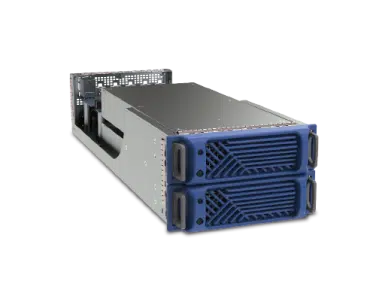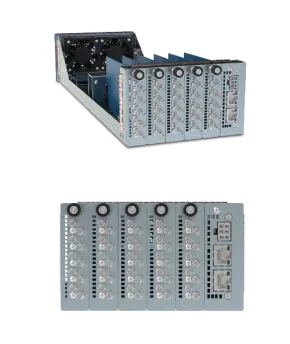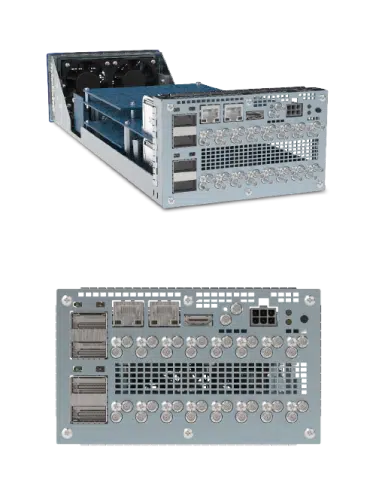Description
Highlights
Media and Communication Technologies
12G-SDI
Support for 12G / 3G / HD/ SD-SDI formats
100 Gbps
Line-rate 100GE packet processing
Ingest and Transcoding
Compliant to ST2110, JT-NM, NMOS
PTP
Synchronization through ST2059 as well as legacy BB / TLS
Software-Defined
Same hardware but different app images
All-Encompassing
Form factor to cover processing as well as signal conversions and distribution
IP, Hybrid, SDI
Apps for every stage of your transition to IP era
API
Integrate OMIX to your existing business
Redundancy
Seamless switching based on ST2022-7
At a Glance
Media and Communication Technologies

The OMIX platform fulfills a significant portion of the processing requirements, as well as the conversion or distribution of signals, within a live production chain. In this blade-based platform, up to three blades can be installed in each 2RU frame. The available blades include:
- The SDI/IP processing blade.
- The signal converter blade can convert or distribute the signals very densely with five slots. Users can choose the required modules independently from available options, such as SDI-to-fiber, fiber-to-SDI, GPIO gateway, SDI distribution amplifier, etc.
- The SDI/IP processing blade.
The latter offers a wide range of functionalities, including IP gateway, format conversion, multiviewer, etc., by utilizing a diverse group of I/Os combined with loaded app images.
OMIX Components
Arrange Blades as You Want:

OMIX Power Supply Blade
- The PSB-50 blade is designed for seamless installation within the DRM-2 frame, delivering essential power to other installed blades. This blade houses two hot-swappable AC to DC power supply modules, ensuring redundancy in operation.
- The AC to DC modules can be effortlessly inserted from the front, while on the rear panel, you’ll find two AC inputs, five DC output connectors, and a network port for monitoring purposes. The web interface provides comprehensive access to voltage and current data for inputs and outputs, along with the operational status of modules and fans.
- Furthermore, the PSB-50 boasts attributes such as high efficiency and robust protection mechanisms against short-circuits, over-voltage, overloads, and over-temperature scenarios. It also complies with electromagnetic compatibility standards.

OMIX 2RU Passive Frame
2RU high, suitable for 19-inch racks. This passive frame can hold three different types of blades.

OMIX 5-slot Signal Converter Blade
- The SCB-50 product is designed to fit into DRM-2 frames, accommodating up to five modules of various types. It allows for easy monitoring and configuration of the installed modules through a web-based interface or API.
- Within this product, you have the flexibility to install various digital signal distribution amplifiers, fiber converters, and GPIO gateways. Importantly, the installation or replacement of modules can be performed without any disruption to the functionality of other modules already in place. Additionally, this blade offers easy front fan replacement.

OMIX X42 SDI / IP Processing Blade
- The OMIX X42 SDI / IP processing blade is built upon advanced FPGAs and a software-defined architecture. This versatile blade is designed to cater to a wide array of live production applications in accordance with the latest open standards. This architecture, combined with the IP infrastructure, delivers the much-needed flexibility, scalability, resilience, and agility required for modern installations.
- On the rear of the device, you’ll find a diverse array of ports, including four 100G Ethernet ports, 32 bi-directional mini-BNC ports supporting 12G-SDI, DC power input, two redundant network ports for out-of-band control, Bi-/Tri-level reference input, and HDMI output. This blade, compatible with the DRM-2 frame, also features a front-accessible replaceable fan module, status LEDs on both the front and rear panels, and call buttons for device identification in the monitoring software.
- Each “App Image” loaded onto this blade can customize the configuration of the mini-BNCs, depending on the app-specific requirements. In general, inputs and outputs support single-link 126, 3G, HD, and SD formats. Synchronization can be achieved through reference input or the PTP protocol.
- Users have the option to monitor and configure the device through the web interface, REST-API, or AMWA NMOS, allowing seamless integration into the SAMIM Broadcast Controller System or other third-party applications.
- This blade offers the flexibility to function as an SDI processor (for tasks such as multi-channel format conversion, frame synchronization, delay adjustment, and MultiViewer), a hybrid processor (serving as a gateway with frame synchronization, distributed frame-accurate routing), or an ST2110 stream processor (without traditional SDI inputs and outputs, for tasks like synchronization, format conversion, color space conversion, MultiViewer).


















Reviews
There are no reviews yet.